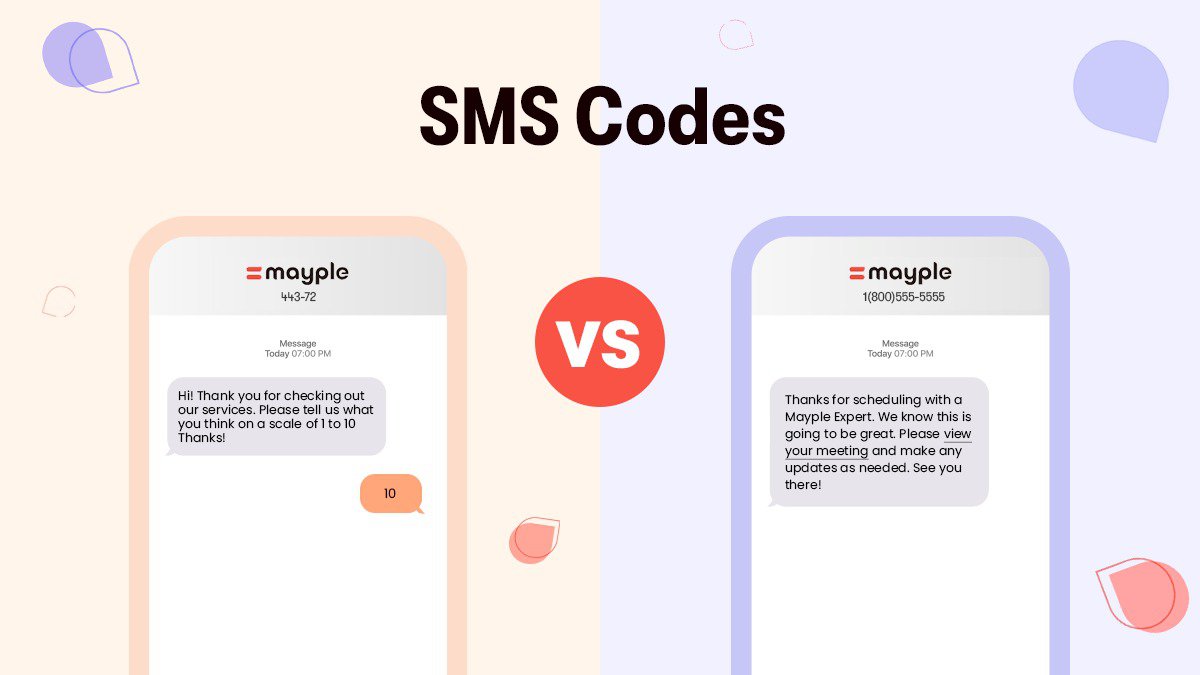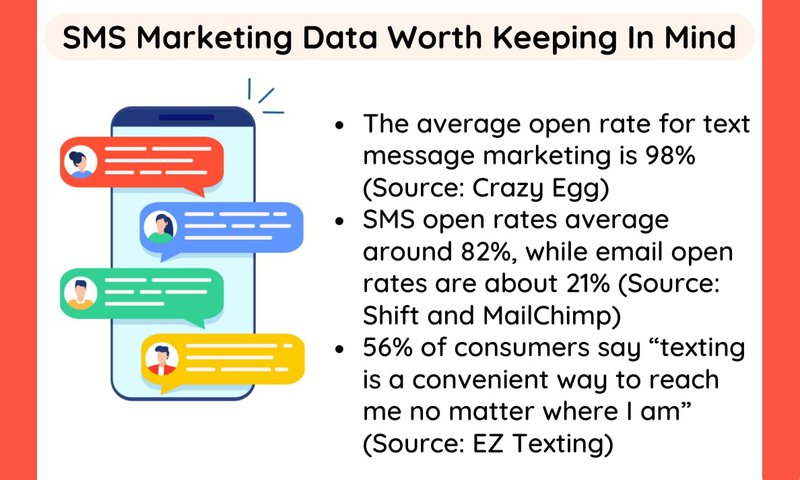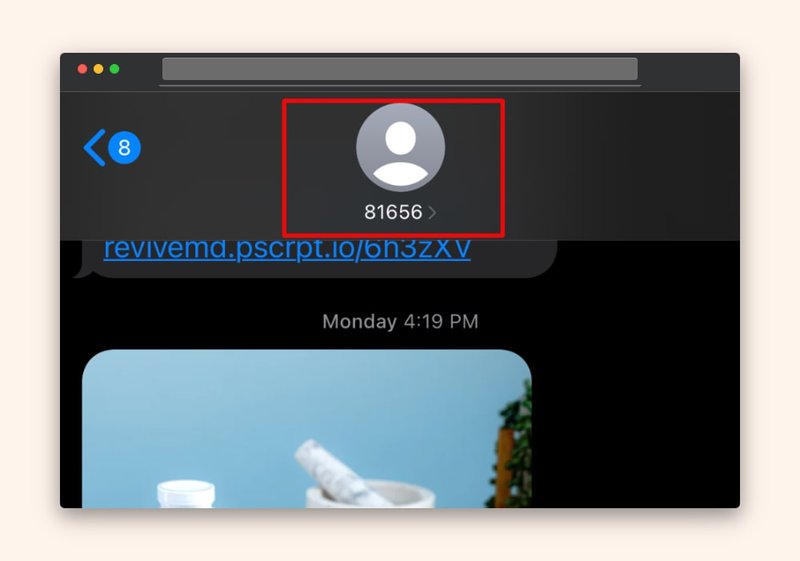SMS Codes Guide: What They Are, Pros + Cons, and Top Tips
SMS marketing is an important tool for communicating directly with your customers. Read about different SMS codes to see what's right for your marketing budget.
Updated November 7, 2024

Have you ever received a text from a company you’ve purchased from? Like a confirmation SMS, or simply a verification code?
You might have noticed a five- to six-digit number at the top, and a reminder that you can unsubscribe by responding with something like “STOP."
That’s a message sent from a business’s SMS code.
SMS codes let you send high-volume messages to customers. many eCommerce businesses are incorporating them into their SMS marketing strategy – with good reason.
What is an SMS code, more specifically, how to get such an SMS service, and how to use it to your online store's advantage?
Let's take a closer look.
What is an SMS code?
An SMS code is a numerical or alphanumeric sequence for sending and receiving text messages (SMS). They’re commonly known as short codes, but that can be misleading, as long codes are used, too (more on that below!).
There are a few different uses for an SMS code:
- Individuals, businesses, or organizations use SMS codes for things like Marketing mobile alerts
- Boosting customer engagement
- Sending two-factor authentication (2FA) verification codes
- Appointment reminders
- Deal alerts
- Push notifications
A text message from an SMS code number looks something like this:
How do SMS codes work?
SMS codes are like virtual numbers businesses use in their mobile marketing and communications to reach customers via SMS messaging. When a business partners with an SMS code provider, they get an SMS code they can use to send mass messages to customers.
For customers to receive the messages, they must opt-in to be included in the messaging list. They can also opt-out to stop receiving the messages.
Need a better platform for SMS codes? Check out one of these SMS tools.
Types of SMS codes
There are two types of dedicated codes:
Short codes
SMS short codes consist of five or six digits, making them easy for users to remember.
The example SMS code text we saw earlier used a short code number:
Short codes are the premium category among other code types because they allow you to send high-volume messages without being flagged as spam.
There are two types of SMS short codes:
- Random codes are given arbitrarily, and the businesses or users deploying them have no control over the number they will receive. The random short code is either a five or a six-digit number, and it's popular because it's the cheaper option of the two types of SMS short codes.
- Vanity codes. Vanity codes are five or six digits, as well. They're more expensive to deploy than random codes because the registry charges premium fees to allow you to select a number of your choice and maintain it on your behalf.
Long codes
Unlike short codes, long codes can be voice-enabled, allowing operators to voice call and conduct two-way communication. Furthermore, in the US, wireless carriers have mandated that all businesses switch to an official long code, as opposed to normal phone numbers.
Long codes consist of 10+ digits and come in two main categories:
- 10-digit long (10DL). 10DL numbers are existing mobile phone numbers, already assigned to your business. They support voice communications and MMS messages, but they do not have delivery receipts (which short codes do).
- Toll-free numbers. Toll-free numbers start with one of the toll-free codes (such as 800, 888, 877, etc.). The main difference between these numbers and 10DLs is that toll-free numbers come without any kind of charge for the caller. They can be used for any kind of messaging, including (but not limited to) marketing communications.
Here’s an example of a text from a long code number:
Top benefits of SMS long codes
SMS long codes have several benefits. Some of the most important ones include:
1. Cost-efficiency
Operating an SMS long code is more cost-effective and affordable for mobile marketing. Acquiring one is simple, and the fees for these code services—including maintenance costs—are generally low.
The messaging services you get from long codes are also more affordable when compared to other communication channels like phone calls and messaging platforms.
This is why long codes attract businesses that need to send high volumes of messages. They can do so without incurring exorbitant costs and fees.
2. Dedicated number
Unlike short codes that can be shared among multiple users, long codes are usually specific, unique numbers dedicated to a particular business or user.
As a result, long codes offer a more personalized messaging experience consistent with the company’s branding.
And since long codes aren’t shared, you eliminate the risk of message delays and communication interference. This makes for highly reliable and timely message delivery, enhancing the overall customer experience.
3. More choices for the number
Businesses that use an SMS long code have more number choices, allowing them to select a specific number that better aligns with their branding.
You can easily select a number that customers can remember or matches your existing phone numbers.
4. International access
An SMS long code offers international texting services. So if you operate globally, you can still offer a personalized experience to your clients, regardless of what country they are in.
Disadvantages of SMS long codes
SMS long code services have a lot of advantages, but they are not flawless. You need to be aware of the disadvantages too. The main cons associated with SMS long codes are:
1. More difficult to memorize
Long codes are lengthy since they consist of 10+ digits. Because they are long, users can find it challenging to memorize them, which might get in the way of effective communication.
It’s easier for users to mistype or even forget the numbers altogether, which leads to missed opportunities and frustrated customers.
Of course, there are ways to counter this disadvantage. For example, you can:
- Provide visual aids
- Make your number easy to find on your website
- Include it on your social media pages
- Print it on cards
- Associate it with music and/or radio jingles
- Use an SMS QR code generator that helps customers send an SMS to a target phone number complete with a pre-filled text message.
2. Doesn’t get through spam filters
Widespread usage of spam and unsolicited messages made network providers and mobile carriers implement strict spam filters to protect their customers. Unfortunately, long-code business messaging often gets caught in these filters.
Unlike dedicated short codes, it’s more challenging to establish a positive reputation for long codes since they’re privately used. This is especially true since many reputable organizations publicly use short codes.
Since long codes can be marked as spam, their deliverability rate tends to be low compared to other communication channels, negatively impacting their effectiveness.
Top benefits of SMS short codes
SMS short codes also come with a lot of benefits:
1. Easy to remember
SMS short codes usually consist of five or six digits, making them simple, short, and easy to remember.
From a customer perspective, these short codes eliminate the need to save lengthy numbers. This comes with its own set of advantages:
- Increased customer engagement
- Customers can share the code with others easily
- Customers recognize who’s texting them, which builds trust and increases the chances they’ll actually read the messages
- It's easier to contact you for help or questions
2. Ideal for high-volume SMS
SMS short codes are designed to handle a high volume of SMS messages.
They can process and deliver thousands of messages per second, allowing businesses to engage with their customers in real time with fast response times.
The high-volume messaging also helps businesses reach a broader audience, scale their communications effectively, and communicate with many customers simultaneously.
The more customers or clients an organization reaches, the greater the engagement, brand recognition, and loyalty.
3. They bypass spam filters
Network providers and mobile carriers pre-approve SMS short codes so they do not get flagged as spam, increasing their delivery rates.
The regulation of short codes by mobile carriers and other regulatory authorities further increases these codes' trust scores, enabling them to bypass spam filters.
And since customers opt-in to receive messages and alerts from short codes, they’re typically more reliable regarding engagement.
Disadvantages of SMS short codes
If you're keen on getting an SMS short code for your mobile marketing and/or customer support, consider the following disadvantages too:
1. High costs
The set-up fees, monthly rental charges, and (sometimes) pre-message expenses add to the high cost of acquiring and maintaining SMS short codes.
These codes are typically leased from mobile carriers or third-party providers that charge fees for providing and managing the short codes.
The high costs of short codes create an entry barrier that small businesses with limited budgets might find it hard to justify investing in them. This often pushes them into exploring communication channel alternatives that are more cost-effective.
2. Complex set-up
Setting up an effective SMS short code often involves complex processes you might not have the skills (or time) for. As a result, you’ll probably need to seek assistance from experienced professionals or service providers. An expert will implement the short code, ensuring it works as intended and is ready for you to use.
3. Restrictive legislation
Different regions and countries have different rules and regulations that might restrict you from leveraging the full potential of short codes.
The most common reasons for these limitations are to protect the consumer, maintain telecommunication services integrity, and prevent spam.
If you have clients or customers in regions with different short code legal frameworks, you might face challenges while implementing your SMS marketing campaigns.
Often, compliance with different regulations needs extra resources, including legal expertise. This process can be time-consuming and expensive, especially for businesses with limited budgets.
What are SMS short codes used for?
SMS short codes are used for sending high-volume messages without running into the risk of being flagged as spam.
Short codes are usually pre-approved by mobile carriers to operate high-volume or time-sensitive messages without being subjected to carrier filtering. This is how they’re able to bypass spam filters.
For example, a fashion eCommerce store might use an SMS short code to notify their customers all at once about a sale they’re running or new arrivals.
The message goes to every customer who has opted into their messaging list, allowing them to notify existing opted-in customers (the ones most likely to buy) about promotions in seconds.
Another example would be companies in the service industry using SMS short codes to send out a message requesting customer feedback from loyal customers.
An SMS short code would allow them to reach all of their previous customers who have opted-in to their messaging list which allows them to get feedback from previous customers.
Can you get an SMS short code for your business?
Yes, you can set up an SMS short code for your business.
Depending on the provider and region, the process will vary. However, most providers will require you to complete a form.
These are the three main steps:
- Step 1: Read and understand the regulations and guidelines of your target region.
- Step 2: Ensure you fulfill all the requirements required.
- Step 3: Fill out an application and wait for your provider to approve your application.
When applying for an SMS short code, make sure you choose a reputable provider. This means considering their experience, reliability, customer support, pricing, and available features.
SMS short codes for international businesses
Short codes are country-specific and can’t be used across borders. This means international businesses must apply for short codes in each country they operate in.
Costs of short codes
In the US, short codes cost about $1,000 per month.
Vanity short codes cost about $2,000 a month. But of course, prices will differ according to the provider.
SMS code best practices
Here are some of the ways you can maximize the results of using an SMS code.
1. Clear expectations on sign-up
Ensure you provide transparent information to your audience when they sign up for your automated messages. Be clear about what kind of messages they will receive and how often.
If you use an eCommerce platform like Shopify, setting up a page explaining the terms, conditions, and expectations before customers opt in is easy. It also might be legally required for SMS mobile marketing efforts – so take care to not skip this step.
2. Honoring opt-outs
Ensure that you honor opt-outs by promptly and effectively processing the requests from your subscribers. Honoring out-opts shows that you respect individual preferences and are committed to keeping your audience’s privacy. Most automation software will handle this for you.
3. Using confirmation messages
Confirmation messages let you follow up to confirm customer actions and requests. Though they're transactional in nature, confirmation messages are important because they keep your recipients in the loop on orders, product or service information, payments, and so on.
4. Advertise your short codes
If your customers don’t know about your messaging program, they’ll never sign up. Make sure they know they can opt in to receive texts and advertise it by explaining the benefits they’ll receive.
For example, opting in to receive messages means they’ll be the first to know when new arrivals come, or new products drop. They’ll also be aware of all sales and discount opportunities.
5. Track subscriber sources
Tracking new subscriber sources helps monitor the channels your new subscribers opt in from. This will also help provide insights into what motivates new customers to join your SMS marketing list, enabling you to better optimize your messaging.
You’ll also know where to focus more of your efforts and which sources might require more time and money than they’re worth.
For example, a home goods eCommerce store might find that 78% of their opt-ins come from the confirmation page after a customer purchases something. Whereas only five percent come from paid ad campaigns, like the landing pages they link to in a Facebook ad.
The company can either put more time and effort into the higher-performing source or focus on increasing the conversion rate of the lower performer.
You can even segment your audience by sign-up source so you send them messages that would interest them the most.
6. Time-limit high-volume texts
Set time limits for sending high-volume messages, especially during large-scale campaigns.
You never want to bombard your message list with texts. That will lead to a wave of unsubscribes and opt-outs. Instead, focus on sending short, concise texts at opportune times.
SMS short code alternatives
If you’ve concluded that short codes aren’t the best option for your business, there are still ways you can take advantage of SMS code marketing.
The most common alternatives to short codes include:
- Long Codes
- Toll-Free Numbers
- Virtual Mobile Numbers
- Messaging APIs
- OTT Messaging Apps
Are SMS codes worth it?
SMS codes are a unique, modern strategy that businesses can use to grow their eCommerce brand fast.
Short codes are the most popular because they bypass spam filters and are easy to remember. Long codes are more cost-effective, specific to your brand, and better for international communication.
No matter which one you choose, SMS codes allow you to start directly communicating with your most loyal customers and automate your SMS marketing at scale.
FAQs
Why use SMS short code?
SMS codes provide an easy and memorable way of communicating with your customers by letting you send high-volume messages without getting flagged as spam.
What's the difference between short codes and other texting numbers?
Short codes only have five or six digits, while other texting numbers contain 10 digits or more. Short codes can also send high-volume messages without being marked as spam.






![What is Growth Marketing? And Why It’s Essential for {year} [+Examples]](https://entail.mayple.com/en-assets/mayple/fit-in/280x280/63ac9f3c09eedbfaa4007ac1_mariogoghgMZfweN0hyQunsplash1_fd135cad83ad50f50ecd4b474d7bde85_2000-1699518527447.jpg)
